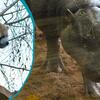A zoo honey badger birth is an extremely rare event in Europe. Keeper Henry King details the development of Exmoor Zoo's little one...
Hello, I am Henry King, a mammal keeper at Exmoor Zoo, primarily working with the category 1 carnivores including our leopard, cheetah, painted dogs and the honey badger (Mellivora capensis), of which I would like to speak about in this blog.
Over the past few months, I am proud to have been part of breeding the honey badgers at Exmoor Zoo alongside the Curator, Derek Gibson and Head Keeper, Ryan Smith. We are absolutely thrilled to have announced that we have welcomed a baby female honey badger in January this year. We are pleased to have achieved something now only done twice on record in the UK, with the first successful breeding of honey badgers being achieved by Howletts Wild Animal Trust in 2016, and has not been accomplished in Europe since 2020. Careful management of husbandry and in-depth research of both wild behaviours and other collections’ experiences were implemented to guide us throughout.
Whilst they are listed as a species of least concern by the IUCN, their distributed population throughout Africa, Southwestern Asia and the Indian subcontinent is in low density. Additionally, the wild population trend is decreasing with them even being a protected species in South Africa. Honey badgers have thick skin which helps to protects them from bee stings, snake bites and helps in defence against larger predators. Known for being fearless and tenacious, and they have been labelled the most fearless animal on the planet by Guinness World Records for fending off lions and hyena.
Besides this, honey badgers are actually a very intelligent and nurturing species. Whilst fathers have nothing to do with rearing, after an average 48-hour mating period, the mother will rear their young entirely alone; defending, feeding and teaching them everything they need to know for the first 12 to 18 months of their life. Once we had established the mating had finished between our breeding pair, we counted down the days to our predicted birth date so we were prepared to move the father. On the 16th of January 2025 we heard squeaking coming from the nest box in the house for the first time, but it wasn’t until 3 weeks later that after cautiously listening for signs of life with minimal disturbance we were gifted our first glimpses of the newborn. At approximately 10cm in length, with very faint honey badger markings and her eyes unopened, she was being carried around by her mother.
Over the course of the next 5 months we saw her grow remarkably fast. At 5 weeks old she had begun to fully open her eyes, develop more distinctive colourations and had grown a small set of claws. At 7 weeks we saw her crawling for the first time and by 10 weeks, movement was described as more walking than crawling; she had developed a longer coat and she had grown to an estimated 25-30cm. At 12 weeks she was beginning to ween from her mother as she was presented with solid foods, and by 16 weeks we estimated her to be ¾ the size of her mother with a nice thick coat, healthy teeth and strong claws, as well as seeking food for herself. At 20 weeks, when we were confident that she was capable of physically navigating a more complex environment, with mother she ventured from the den for the first time, into their newly revamped outside enclosure.
It has been quite the journey for our juvenile female honey badger, who, at six months old, is now the same size as her mother, and she is still getting stronger and more coordinated each day. We have chosen to name her ‘Freya’, after the Norse goddess who represented love and beauty as well as chaos and power, which we felt perfectly captured her character. Seeing her explore the new environment for the first time overwhelmed us with pride from what we had achieved, watching as she navigated new obstacles, smells and sensations, as a whole new level of simulation surrounded her was incredibly fulfilling.
Since leaving the den, it is clear she is becoming more confident, spending most her day digging, climbing and tackling all sorts of new enrichment we are presenting them with; this includes food-based, sensory and cognitive forms of enrichment, to continue challenging her in new ways and support her development. We are enjoying watching her continued development and are looking forward to see what the future holds!
- Henry King, Mammal Keeper, Exmoor Zoo
All blogs reflect the views of their author and are not necessarily a reflection of BIAZA's position
Related Members
-
News
 Belfast Zoo helps to bring Christmas joy to Children’s Hospital 19th December, 2025Belfast Zoo joined the Lord Mayor of Belfast, Councillor Tracy Kelly, on Monday (15th December) to help bring festive cheer to the Royal Belfast Hospital…
Belfast Zoo helps to bring Christmas joy to Children’s Hospital 19th December, 2025Belfast Zoo joined the Lord Mayor of Belfast, Councillor Tracy Kelly, on Monday (15th December) to help bring festive cheer to the Royal Belfast Hospital… -
News
 Colchester Zoological Society welcomes new arrivals 19th December, 2025This December, Colchester Zoological Society (CZS) welcomed some exciting new arrivals! A young male pygmy hippo, Mikolas, from Zoo Dvur Kralove…
Colchester Zoological Society welcomes new arrivals 19th December, 2025This December, Colchester Zoological Society (CZS) welcomed some exciting new arrivals! A young male pygmy hippo, Mikolas, from Zoo Dvur Kralove… -
News
.png?w=100&h=100&zc=1&f=jpeg&hash=8d175f93cde920c5ba23c8ea7f92e55a) Blog: Understanding the human side of zoos 16th December, 2025Why are zoo researchers increasingly looking to social science? Dr Nieky van Veggel explains the significance of understanding the human dimension…
Blog: Understanding the human side of zoos 16th December, 2025Why are zoo researchers increasingly looking to social science? Dr Nieky van Veggel explains the significance of understanding the human dimension…

.png?w=100&h=50&zc=1&f=jpeg&hash=b037856f14c94e02296b0c0026fb569c)

